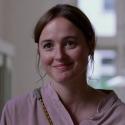When the French painter Fabienne Verdier told me she’d been invited to explore the relationship between painting and music at the world-famous Juilliard School in New York, I knew straight away that this unusual residency should be documented.
Fabienne is an adventurer. In her early 20s, she had courageously embarked on a journey of discovery. She was one of the very first French art students to go on an exchange programme to China, only a few years after the end of the Cultural Revolution. She had a really difficult time there, as she looked for a traditional calligrapher with whom she could study. Most traditional artists and philosophers had been forced into internal exile and sometimes tortured during the recent upheavals. But she eventully found a master, who was at first reluctant to take her on, and who had her doing nothing more than painting a straight line with her brush for several months. She had to learn to be in the moment, to become a channel for the energies of nature, not least the force of gravity. Her book about her time in China, Passagère du Silence, continues to be a bestseller in France.
On her return to France, inspired by the lessons of her Chinese master, she started making increasingly large non-figurative works, close in spirit to the Abstract Expressionists – Kline, De Kooning, Pollock and others – who privileged a gestural and physical approach to painting. She worked with very large Chinese brushes, some of them gigantic, and suspended on a bungee from a gantry in her studio.
I made a film about her for French television five years ago – Fabienne Verdier: Painting the Moment – and have kept in touch ever since. The residency at Juilliard, and the way in which she embraced the somewhat risky idea of collaborating with musicians, were typical of her insatiable curiosity and willingness to explore new ground. As we started filming the various encounters with musicians at the school, I realised that something very special was happening, a process that illuminates both painting and music-making. The documentation process naturally grew into a feature-length film, which will be premiered at this year's Raindance Film Festival.
 I was fortunate that Ghislain Baizeau, Fabienne’s husband, devoted assistant and manager, had decided to film much of her work in New York from underneath a glass table. He was inspired by the famous Henri–Georges Clouzot documentary, Le mystère Picasso (1956), in which the painter was filmed painting on glass with the camera placed behind it.
I was fortunate that Ghislain Baizeau, Fabienne’s husband, devoted assistant and manager, had decided to film much of her work in New York from underneath a glass table. He was inspired by the famous Henri–Georges Clouzot documentary, Le mystère Picasso (1956), in which the painter was filmed painting on glass with the camera placed behind it.
In the spirit of the work, in which so much depended on focusing on the moment, the film is mostly observational in style, and sometimes slow: not quite watching the paint dry, but trying to evoke something of the nature of reflection and communication. Although, in typically French style, Fabienne has a tendency to talk a lot and intellectualise her work, she is the first to admit that words aren’t the best medium for describing a process that, in its very essence, works in non-verbal space. In the film, we watch her watching and listening. The musicians too, not least the jazz improvisers, watch her working and react. There is a dialogue, often so subtle that is hard to perceive, and yet it clearly touches the people involved.
I don't believe that there is an obvious or literal connection between music and painting. This would be no more than illustration, which isn't what Fabienne is seeking to achieve. She senses instead a kind of interpersonal resonance in the act of creation – she calls it a concomitance – as if the people making the work, music or painting, were breathing the same air, sharing a creative space and moving to the same rhythm.
It’s perhaps appropriate that the film should have its first screening in London at a time when Abstract Expressionism is being celebrated at the Royal Academy. The painters of the New York School referenced music, although they didn’t claim any direct relationship between such fundamentally different creative activities. Fabienne owes a lot to them, and anyone interested in AbEx will very likely enjoy a film that shows in exceptional detail and great intimacy how this particular artist makes work.
- Watch the trailer for The Juilliard Experiment
- The Juilliard Experiment is shown at the Raindance Film Festival on Saturday 1 October at 12.30 at the Vue Piccadilly. The screening will be followed by a Q & A with the director
- Fabienne Verdier is exhibited at Waddington Custot, 11 Cork Street, London W1S 3LT from 25 November to 4 February














Add comment